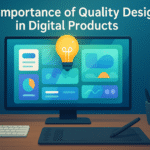How to Create Engaging Digital Products for Educational Purposes
In today’s fast-paced digital world, creating engaging educational products is more important than ever. Whether you’re an educator, a content creator, or an entrepreneur, understanding how to design digital products that captivate and educate your audience can set you apart in the digital marketplace. In this guide, we’ll explore what it takes to create compelling educational digital products that not only engage but also drive learning outcomes.
Table of Contents
1. Understanding Your Audience 👩🎓
2. Choosing the Right Type of Digital Product 📘
3. Designing for Engagement 🎨
4. Incorporating Interactive Elements 🖱️
5. Leveraging Multimedia Components 📹
6. Testing and Feedback 🔍
7. Conclusion: The Future of Educational Digital Products 🚀
8. FAQs ❓
Understanding Your Audience 👩🎓
Before you even start designing your digital product, it’s crucial to understand your target audience. Who will be using this product? Are they high school students, college students, or professionals seeking further education? Knowing the demographic details like age, background, and learning preferences can help tailor your content to fit their needs and learning styles. Conduct surveys, or hold focus groups to gather insights that will guide your product development process.
Choosing the Right Type of Digital Product 📘
Digital products for educational purposes can take many forms, from eBooks and online courses to mobile apps and interactive simulations. The type of product you choose should align with both your audience’s needs and your own expertise. If you have a wealth of written content, consider compiling it into an eBook. If you’re adept at video creation, an online course might be the best route. The key is to match the format with the educational objectives you aim to achieve.
Designing for Engagement 🎨
Engagement is the cornerstone of effective learning. To design an engaging digital product, consider incorporating elements like storytelling, gamification, and personalized learning paths. Storytelling can make complex information more relatable, while gamification can motivate learners through rewards and challenges. Personalized learning paths allow users to progress at their own pace, enhancing the learning experience.
Incorporating Interactive Elements 🖱️
Interactivity is a powerful tool for engagement. Features like quizzes, simulations, and interactive infographics can transform a passive learning experience into an active one. Interactive elements not only boost engagement but also enhance retention by allowing learners to apply what they’ve learned in real-time. Tools like Kahoot! and Quizlet offer easy ways to add interactivity to your digital products.
Leveraging Multimedia Components 📹
Incorporating multimedia elements such as videos, podcasts, and animations can significantly enhance the learning experience. These components cater to different learning styles, whether visual, auditory, or kinesthetic. Videos can provide demonstrations that are more effective than text alone, while podcasts allow learning on the go. Utilizing a mix of media keeps the content fresh and engaging.
Testing and Feedback 🔍
Once your digital product is ready, it’s time to test it with a segment of your target audience. Gather feedback to understand what works and what doesn’t. This can involve observing how users interact with your product, conducting interviews, or using analytics tools to track engagement metrics. Feedback is invaluable for making improvements and ensuring that your product meets the needs and expectations of your learners.
Conclusion: The Future of Educational Digital Products 🚀
The landscape of educational digital products is constantly evolving, driven by technological advancements and changing learning preferences. By focusing on your audience, choosing the right format, and incorporating engaging and interactive elements, you can create products that are not only educational but also captivating. Remember, learning is a journey, and your digital product is a vehicle that can make this journey both impactful and enjoyable.
FAQs ❓
Q1: What are some popular platforms for creating digital educational products?
A1: Some popular platforms include Teachable for online courses, Canva for creating eBooks and infographics, and Adobe Captivate for interactive e-learning content.
Q2: How can I ensure my digital product is accessible to everyone?
A2: Ensure your product is accessible by following best practices such as using alt text for images, providing transcripts for videos, and ensuring compatibility with screen readers.
Q3: How often should I update my digital product?
A3: Regular updates are important to keep your content fresh and relevant. Consider updating your product annually or whenever there are significant changes in the subject matter.
Creating engaging digital products for educational purposes is a rewarding endeavor that combines creativity, technology, and pedagogy. By following these guidelines, you can develop a product that not only educates but also inspires learners to reach their full potential. Happy creating! 🎉
Free Download!
Best Digital Product – eBooks, templates, AI tools, courses, and mor






